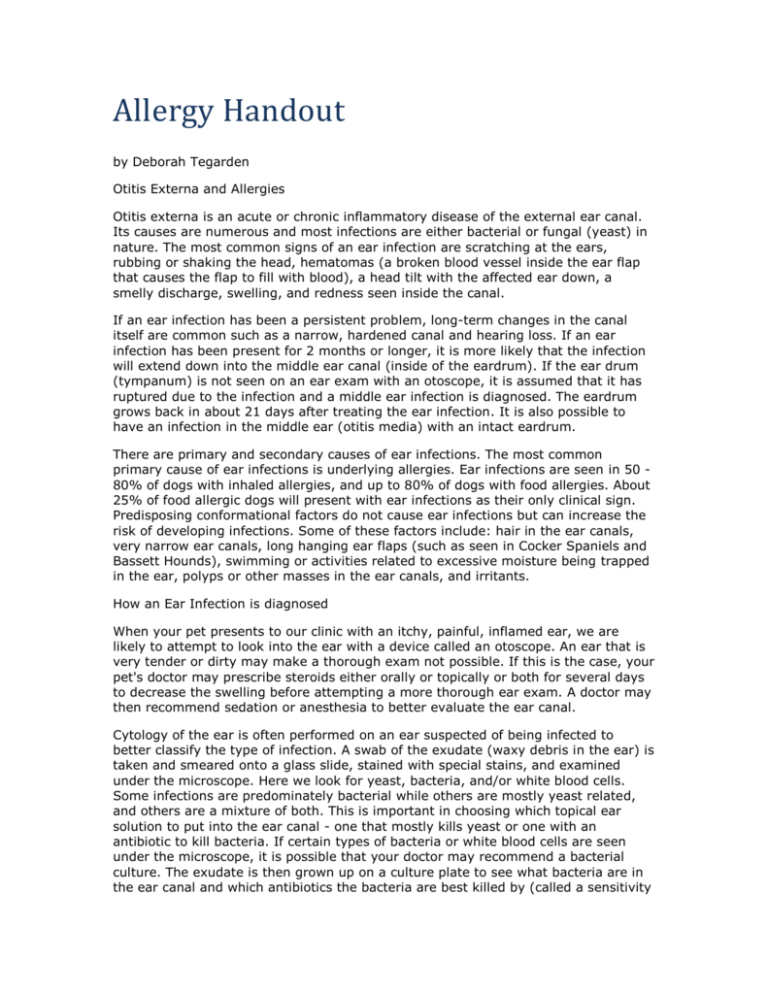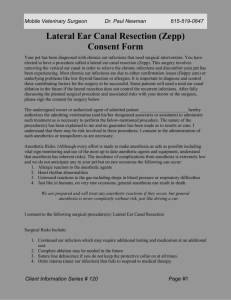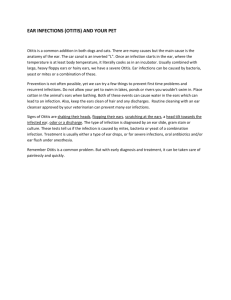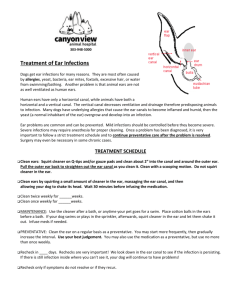Allergy Handout by Deborah Tegarden Otitis Externa and Allergies
advertisement

Allergy Handout by Deborah Tegarden Otitis Externa and Allergies Otitis externa is an acute or chronic inflammatory disease of the external ear canal. Its causes are numerous and most infections are either bacterial or fungal (yeast) in nature. The most common signs of an ear infection are scratching at the ears, rubbing or shaking the head, hematomas (a broken blood vessel inside the ear flap that causes the flap to fill with blood), a head tilt with the affected ear down, a smelly discharge, swelling, and redness seen inside the canal. If an ear infection has been a persistent problem, long-term changes in the canal itself are common such as a narrow, hardened canal and hearing loss. If an ear infection has been present for 2 months or longer, it is more likely that the infection will extend down into the middle ear canal (inside of the eardrum). If the ear drum (tympanum) is not seen on an ear exam with an otoscope, it is assumed that it has ruptured due to the infection and a middle ear infection is diagnosed. The eardrum grows back in about 21 days after treating the ear infection. It is also possible to have an infection in the middle ear (otitis media) with an intact eardrum. There are primary and secondary causes of ear infections. The most common primary cause of ear infections is underlying allergies. Ear infections are seen in 50 80% of dogs with inhaled allergies, and up to 80% of dogs with food allergies. About 25% of food allergic dogs will present with ear infections as their only clinical sign. Predisposing conformational factors do not cause ear infections but can increase the risk of developing infections. Some of these factors include: hair in the ear canals, very narrow ear canals, long hanging ear flaps (such as seen in Cocker Spaniels and Bassett Hounds), swimming or activities related to excessive moisture being trapped in the ear, polyps or other masses in the ear canals, and irritants. How an Ear Infection is diagnosed When your pet presents to our clinic with an itchy, painful, inflamed ear, we are likely to attempt to look into the ear with a device called an otoscope. An ear that is very tender or dirty may make a thorough exam not possible. If this is the case, your pet's doctor may prescribe steroids either orally or topically or both for several days to decrease the swelling before attempting a more thorough ear exam. A doctor may then recommend sedation or anesthesia to better evaluate the ear canal. Cytology of the ear is often performed on an ear suspected of being infected to better classify the type of infection. A swab of the exudate (waxy debris in the ear) is taken and smeared onto a glass slide, stained with special stains, and examined under the microscope. Here we look for yeast, bacteria, and/or white blood cells. Some infections are predominately bacterial while others are mostly yeast related, and others are a mixture of both. This is important in choosing which topical ear solution to put into the ear canal - one that mostly kills yeast or one with an antibiotic to kill bacteria. If certain types of bacteria or white blood cells are seen under the microscope, it is possible that your doctor may recommend a bacterial culture. The exudate is then grown up on a culture plate to see what bacteria are in the ear canal and which antibiotics the bacteria are best killed by (called a sensitivity test). This can be especially important in ongoing infections because resistance of the bacteria to the more commonly used antibiotics may occur. Cleaning the ear is essential for a good response to the medications prescribed. "Pus" in the ear or a lot of exudate (wax) will inactivate most medications and prevent them from reaching the full length of the canal. Cleaning also removes any possible foreign bodies present in the canal and can help decrease the inflammation in the ear. This is usually done when the ear infection is diagnosed in the clinic. The initial cleaning we do here helps us to do a better exam of the ear canal and eardrum and also helps us be sure your pet starts with a clean ear to receive medication. The ear flushing done in the hospital may be done awake, but some ears have such a severe infection or are so painful that the flushing must be done under anesthesia. Treatment at home will usually include an ear cleansing solution. This is used so that new debris that forms after the ear flushing is broken down and removed so that the medications continue to penetrate deep into the ear canal. Be sure to use the ear cleanser at least 30 minutes prior to medicating the ear. I usually recommend cleaning the ears while you are medicating them every day to every other day, depending on how much debris is being produced. Once the infection is resolved, using the cleanser on a regular basis (every one to two weeks) will change the pH in the canal to make the environment less desirable for both yeast and bacteria. Also, using the ear cleanser after every time your pet goes in the water (both swimming and bathing) will help dry out any water that may have gotten into the ear canal. Topical treatments in the ear are usually in a cream or liquid form. It is important to put enough medication into the ear that it will reach down to the eardrum. This usually takes about a quarter-sized dollop. Holding the flap up in one hand while massaging the canal with the other hand will help get the medication deep into the canal. The doctor may or may not add on oral medications. This usually depends on if they suspect a middle ear infection is present. Treatment for simple, acute, ear infections may be as short as one to two weeks. More chronic infections or resistant bacterial infections may need to be treated for six to eight weeks and may involve follow-up examinations and cultures. Diagnosing and Treating the Underlying Allergy The three most common allergies I see are inhaled allergy (known as atopy), food allergy, and flea allergy. Atopy is a genetically inherited over reaction of the immune system to allergens in the environment such as pollens, grasses, dust mites, etc. Food allergy is an immune-based reaction to a food, usually to the protein source of the food. Flea allergy is when the saliva from the flea bite itself causes an immune reaction and itchiness that leads to the pet scratching and causing skin sores. Food Allergy Data from a study done at Colorado State University shows that Retrievers may be at a greater risk to develop food allergy than other breeds. Terriers may or may not also have an increased incidence of food allergy. This may occur at any age, in fact several researchers now feel that at least 33% of their food allergic patients are less than 1 year of age. One common misconception associated with food allergy is that the pet must have had a change in its diet to develop the allergy. Food allergies develop when exposed to the same protein source over time, so it is much more common to occur when the pet has been on the same diet, or same protein source. The most common clinical sign of food allergy is generalized itchiness (pruritis) that is not seasonal in nature. If this is the first year the pet is itchy, it may be difficult to determine whether or not it will follow a seasonal pattern. Pruritis of the feet and the ears are very common locations in the dog and pruritis of the head and face are common locations for the cat. Concurrent GI (gastrointestinal) signs in dogs with skin signs of food allergy are rare. Typical GI signs that can be seen with food allergy are mucus in the stool, straining to defecate, blood in the stool, and increased fecal frequency; however, these can be subtle changes. General malaise and neurologic signs such as seizure have been reported in association with food allergy on a rare basis. There is no single skin or blood test that is effective in diagnosing food allergy. The ideal method of diagnosis is feeding elimination or "hypoallergenic" diet. Elimination diets generally contain one protein and one starch. This protein source must be one that the dog or cat has not been exposed to before in any other diet. Some examples of these novel protein sources are duck and potato diets, and venison diets. Another option is a technology that Hill's Z/D and Purina's HA veterinary diets follow in which an every day protein source, such as chicken or beef, is broken into such small particles that the immune system no longer recognizes them as proteins and therefore doesn't mount an immune-response to them. Other than fresh water, nothing else should be fed during the elimination diet trial. This means that vitamins and chewing toys that are flavored must be eliminated, and any flavored medications or preventatives, such as flea/parasite controls or flavored Rimadyl®, should be replaced with non-flavored preparations. Toothpaste that is protein-flavored, such as poultry-flavored, should be replaced with the maltflavored variety. Using a commercially prepared diet will give an approximately 90% chance of determining a food allergy; however, none of these diets will work for all animals, and failure of an animal to improve on a diet may warrant trying another one, or trying a home-cooked diet in another diet trial. Positive results from the diet trial are usually seen between 8 and 12 weeks. Once the trial is complete, all secondary infections (bacterial or yeast) are resolved, and the owner feels there has been a significant improvement in the pet's itchiness, a dietary challenge is recommended to confirm the diagnosis. The pet should be fed it's regular dog food again for one to two weeks and any signs of recurrence will usually point to the diagnosis of food allergy. The elimination diet should then be restarted. The resolution of this new flare up won't take the 8 to 12 weeks to resolve again; it usually will be under control again in about one week. At this point, the owner has a choice to either continue with an elimination diet that has been working or to challenge the pet with different suspected allergens, one at a time, to try to determine which allergen the pet is allergic to. It is rare for a pet to be allergic to more than two allergens. The most common proven allergens in the dog are beef, chicken, milk, eggs, corn, wheat, and soy. In the cat, fish and milk products are most common. Feed each allergen for one to two weeks at a time and watch for a flare up of itchiness. Once the offending allergens are identified, commercially prepared dog foods that do not contain them may be fed to the dog or cat. Inhaled Allergy (Atopy) Atopy is arguable the second most frequent allergy in dogs (fleas are number one) and the third most frequent allergy in cats (after fleas and food). The disease is a hypersensitivity reaction of a segment of the immune system. Inhaled allergy can be either seasonal or non-seasonal. In general, non-seasonal inhaled allergies tend to be to house dust mites, storage mites, cockroaches, moths, danders, and molds. Seasonal allergies are more directed toward tree pollens in the spring, grass pollens and outdoor molds in the summer, and weed pollens in the fall. The allergens gain entry to the body either through the skin or through the respiratory system (through the lungs). To help aid in diagnosis of atopy, a skin or serum (blood) allergy test, or sometimes both, are done at the dermatologists. The debate is still ongoing which diagnostic tool is best, skin versus blood tests. Historically, intradermal testing (skin testing) has been the gold standard; however, it is important to understand the intradermal testing is not a perfect test and is subject to many variables. Because diagnosing inhaled allergy is so difficult, it is important that you and your veterinarian have ruled out the possibility of flea allergy and food allergy. Any pet exhibiting signs of allergy should be on year round flea control whether any signs of fleas are seen or not. Flea allergic pets can become very itchy from only a couple of fleabites. It is best to use a product that kills fleas before they bite the pet, such as Advantage® (Bayer) or Frontline® (Rhone-Meraux). These may be used in combination with a growth-inhibitor (a flea product that prevents flea eggs from developing into adult fleas but does not kill adults) such as Program® (Novartis). A dietary trial should also be performed to rule out food allergy. A dermatologist will perform the skin and/ or blood testing to help determine allergens in the environment your pet may be allergic to. The interdermal testing involves injecting small amounts of liquid allergens (such as different trees, grasses, dust mites, dander, feathers) just under the skin and measuring which ones form a reaction at that injection site. The main goal of doing such testing is to then mix up a vial of the different allergens the pet reacts to and start what is called hypo sensitization shots. This means exposing the body to increasing amounts of what they are allergic to. Over time, the goal is that the immune system will be less and less "surprised" by the allergen and therefore decrease its response to the allergen (the allergy). About 50% of cats and dogs that have received "allergy shots" will have an excellent response. Another 25% get a partial to good response, and about 25% show no or little response to the treatment. It is important that any anti-itch medications be discontinued for a period of two weeks for topical products (sprays, ear, and eye steroid products) and four weeks for oral products (prednisone tablets) before testing is performed. Antihistamines should be withdrawn 10 days prior to testing. Fatty acids and anti-yeast medication (Ketoconazole) are not known to interfere with the intradermal testing. If allergy testing is not pursued or if anti-itch medication is needed while waiting for testing, there are several options. Products that contain essential fatty acids have been used to aid in stopping the itch associated with allergy. These drugs interfere with the production of arachidonic acid, a known "pro-inflammatory" substance made by the body. Essential fatty acids have also been shown to increase the effectiveness of antihistamines if the two are used in conjunction. In dogs, these supplements may have as high as a 25% chance of reducing the itch associated with inhaled allergies. Antihistamines used together with essential fatty acids may give relief in as high as 50% of cases. Antihistamines work by helping block the histamine release from the body, which is a potent cause of itch. There are many different antihistamines available, mostly human products, and not all animals will respond the same to one antihistamine. Sometimes trying different antihistamines, each for one week at a time, will prove one more effective for your pet. Drowsiness is the major side effect reported with the use of antihistamines. Glucocorticoids, or steroids, are extremely effective in eliminating the itch associated with inhaled allergy. If possible, topical preparations, such as sprays, will allow fewer steroids to be absorbed systemically. When oral steroids are used, they are started at a higher dosage and then the pet is tapered off the medication gradually. This is very important when using steroids so that the adrenal gland is not "shocked" into stopping producing the natural steroids within the body. The immediate side effects of steroid use are an increase in thirst, appetite, and urination. This may lead to urinary "accidents" in the house. Long term use of steroids or steroids used at higher dosages may cause any of the following side effects: dull, dry hair coat, weight gain, panting, vomiting, diarrhea, GI ulcers, increased liver enzymes, pancreatitis, muscle wasting, behavior changes, and adrenal gland problems. Any animal that is on steroids long term should have their urine cultured for bacterial growth every three months because steroids can mask the typical clinical signs of bladder infection. Bacterial and fungal infections can occur or worsen if already present while on steroids. Cats are generally more resistant to the side effects of steroid use than dogs. These are all important aspects to consider with your veterinarian when determining if steroids are right for your pet. Shampoos and cold-water baths can be another helpful itch reliever. Oatmeal based shampoos, antihistamine shampoos, or products such as the Relief line (DVM products) that contain Pramoxine HCL, can help sooth inflamed skin. Pramoxine is a topical anesthetic you may recognize from human products such as Caladryl lotion. The DVM line of products also makes a Relief cream rinse and spray. Allergies affect nearly 15% of our pet population. This number is similar to the number of people affected by allergies. Allergies in pets can often be frustrating to diagnose and usually involve a lifetime of treatment. Treating cases when they are just beginning can make the outcomes more rewarding than waiting until they become severe.





